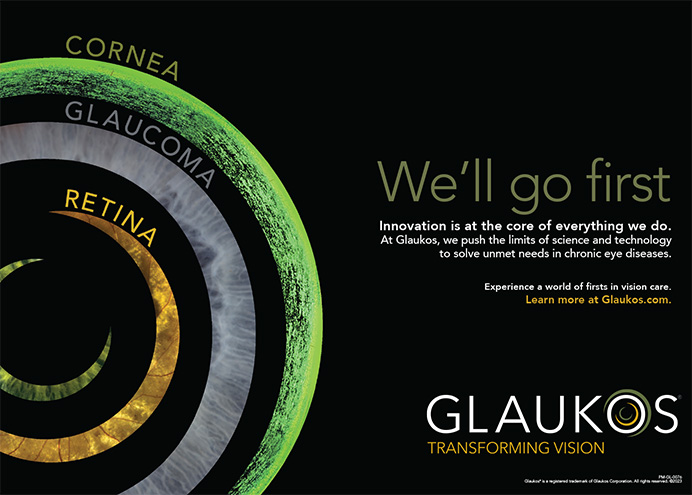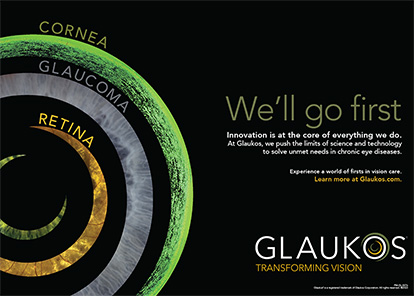Prospective studies have shown that the severity and duration of dry eyes and decreased corneal sensitivity after LASIK can be related to factors such as the degree of myopic correction, the width and position of the flap's hinge, and the depth plate.1-3 When treating this condition, I favor a stepwise approach based on the severity of the dryness and the patient's response to treatment.
First, I identify potential exacerbating factors for dry eye disease, including various systemic medications (ie, antihistamines) and systemic diseases (ie, rheumatoid arthritis). Stopping medications and treating the underlying systemic diseases can improve ocular wetting. Other ophthalmic conditions that can provoke or accompany dry eye disease include lagophthalmos, blepharitis, meibomian gland dysfunction, and ocular rosacea, all of which may require treatment with warm compresses, lid hygiene, artificial tears, topical antibiotics/steroids, and oral doxycycline.
My second step is to supplement the tear film with artificial tears. I recommend starting with a truly preservative-free agent in a disposable tube such as Refresh Plus (Allergan, Inc., Irvine, CA) and then moving to more viscous agents such as Refresh Celluvisc or Refresh P.M. (both Allergan, Inc.) at bedtime for at least 1 month. I counsel patients to continue regular, frequent dosing of these tear supplements, regardless of whether their eyes feel dry, because neurotrophic keratopathy following LASIK can mask the symptoms of dry eye disease.
If necessary, my third step involves stabilizing and normalizing the ocular surface with an anti-inflammatory agent. In clinical trials, Restasis (cyclosporine 0.05% ophthalmic emulsion; Allergan, Inc.) increased tear production, decreased ocular surface inflammation, and helped restore a more normal tear film composition by breaking the abnormal neuronal feedback loop associated with dry eye disease.4 Patients should continue b.i.d. dosing for at least 1 month until reevaluation can confirm improvement. Mild topical corticosteroids (ie, FML ophthalmic suspension [Allergan, Inc.] or Alrex ophthalmic suspension [Bausch & Lomb, Rochester, NY]) may also help decrease acute inflammation, but their long-term use is discouraged because of adverse side-effects.
Fourth, I will place collagen, silicone, or acrylic plugs in the lower puncta or canaliculi, followed by the upper puncta if need be. If inadequate occlusion persists, I may attempt punctal cauterization. Protective goggles can protect eyes against dry heat, wind, dust, and other environmental stimuli, and moisture chambers can limit the evaporation of tears at night.
If all of these steps fail, I consider more aggressive medical and surgical strategies, which may require referral. Options include secretagogues, tear supplementation with autologous serum, bandage contact lenses, and tarsorrhaphy. Most cases of post-LASIK dry eye improve with time and rarely require such drastic measures.
STEVEN B. SIEPSER, MD, FACSRestasis was introduced for the treatment of recalcitrant dry eye. In my practice, the agent initially only seemed to help patients with significant superficial punctate keratitis and moderate staining. A portion of these individuals, however, cannot tolerate the medication due to associated ocular stinging or redness.
I was amazed, however, by how well Restasis controlled rejection, allowed re-epithelialization, and increased patients' comfort after penetrating keratoplasty. As a result of this ability to suppress cell-mediated response, I began using the product more aggressively after LASIK. Initially, my colleagues and I were impressed with the decline in dry eye complaints. We then began to suspect that Restasis limited regression as well, and we began instilling the agent in select cases of undercorrection the way we had used steroids in PRK to decrease regression. Our clinical impression has been that it seems to help in reducing regression. We await research on this observation by one of our colleagues with a more statistically significant population to study. With any group of medications, there are official indications, and then there is the way in which agents are used in a busy practice.,/p>
STEVEN J. DELL, MD
Post-LASIK dry eye can be frustrating, and it is often preferable to optimize dry eye therapy pre- versus postoperatively. A correct diagnosis is obviously important, and physicians should exclude other forms of tear film dysfunction before assigning blame solely to the neurotrophic dry eye state of the post-LASIK eye. Specifically, meibomian gland dysfunction should be treated aggressively if present. In general, our understanding of dry eye syndrome has evolved to emphasize the inflammatory component of this condition.
My regimen for LASIK-related dry eye typically includes the preoperative placement of either silicone or synthetic absorbable plugs in the patient's inferior puncta. The latter plugs typically dissolve in a few months and may be replaced if need be. I rely increasingly upon oral supplementation with the omega-3 fatty acids found in flax seed and fish oils, and I ask high-risk patients to start taking the supplements approximately 2 weeks preoperatively. I believe the quality of these patients' preoperative measurements subsequently improves, which is especially important for wavefront-driven treatments.
In my experience, no single brand of preservative-free artificial tears works best for all patients. Sometimes a bit of experimentation is necessary in order to find the most comfortable and effective drop for a given individual. I encourage patients to use artificial tears preoperatively and for several weeks postoperatively, even if they have no symptoms of dry eye. Those with symptomatic dry eye not relieved by these measures may benefit from a 2- to 3-week course of a weak topical steroid such as Alrex t.i.d. I reserve Restasis for cases that do not respond to any of these measures, and I have found it to be very helpful in such instances.
LOUIS E. PROBST, MDMy philosophy regarding postoperative LASIK lubrication is “the wetter, the better.” Having a very low threshold for initiating corrective measures in patients who have the potential for dry eyes after LASIK can avoid the problem in the majority of cases.
Of course, any signs or symptoms of dry eye or blepharitis should be completely resolved prior to LASIK. I use prophylactic treatment for patients who have the potential for developing dry eyes, such as those with contact-lens intolerance, those older than 40 years, and presbyopic females. I have found that Restasis is very effective for the treatment and, mainly, the prevention of dry eye after LASIK. My associate, John Lehr, OD, and I prescribe this agent for approximately 50% of our LASIK patients. Often, this treatment will begin 1 week prior to the LASIK procedure and continue for several weeks postoperatively. Although some physicians have expressed concern over the medication's cost, we have not found this to be a significant drawback, because many patients' insurance will cover the prescription. For those without coverage, the price of Restasis is only a small fraction of the procedure's cost, and the patients appreciate our efforts to ensure the best visual outcome. When dry eye occurs postoperatively, we insert silicone punctal plugs, because they are much more effective than the temporary collagen plugs.
JOHN F. DOANE, MD, FACSMy strategies for dry eye after LASIK boil down to answering these questions. First, will this be a transient condition lasting 3 to 4 months, or will it be long-lasting? Second, what is the mechanism of the dry eye? Is it a glandular problem with aqueous deficiency, inadequate mucin, or meibomian gland dysfunction? Is acne rosacea an associated condition, or is the cornea excessively flat or steep?
If aqueous deficiency is present, I will start with tear replacement, either Genteal Gel (Ciba Vision, Atlanta, GA) or Refresh (Allergan, Inc.), but I will add more lubricating drops if there is significant desiccation. If the patient uses more than six to eight drops per day, I will perform a trial with collagen plugs. If this treatment is successful, I will place a 60-day collagen plug, the Soft Plug (OASIS Medical, Inc., Glendora, CA), for what seems to be a transient situation. For chronic aqueous deficiency, I will either perform punctal cautery, my preferred choice, or insert nondissolvable plugs, such as the Parasol (Odyssey Medical Inc., Memphis, TN). Even with plugs in both puncta, some patients will require tears or lubricants. My mucin-deficient patients receive a lubricating tear preparation. For those with meibomian gland dysfunction or acne rosacea, I will institute warm packs q.i.d. along with gentle massage. For patients whose eyes are significantly inflamed, I will pulse them with topical corticosteroids for 1 to 2 weeks. In cases of acne rosacea, I will prescribe low-dose doxycycline (Periostat 20mg; Collagenex Pharmaceuticals, Inc., Newtown, PA) orally every day for several months and then discontinue the agent and observe the patient.
Steven J. Dell, MD, is Director of Refractive and Corneal Surgery at Texan Eye Care in Austin, Texas. He is a consultant to Bausch & Lomb. Dr. Dell may be reached at (512) 327-7000; sdell@austin.rr.com.John F. Doane, MD, FACS, is in private practice with Discover Vision Centers in Kansas City, Missouri, and is Clinical Assistant Professor for the Department of Ophthalmology, Kansas University Medical Center. He states that he holds no financial interest in the products or companies mentioned herein. Dr. Doane may be reached at (816) 478-1230; jdoane@discovervision.com.
Terry Kim, MD, is Associate Professor of Ophthalmology, Cornea and Refractive Surgery Services, at Duke University Eye Center in Durham, North Carolina. He states that he holds no financial interest in the products or companies mentioned herein. Dr. Kim may be reached at (919) 681-3568; terry.kim@duke.edu.
Louis E. Probst, MD, is Regional Medical Director for TLC Laser Eye Centers in Canada and the US. He is a consultant for Bausch & Lomb and Visx, Incorporated. Dr. Probst may be reached at (800) 463-2020.
Steven B. Siepser, MD, FACS, is Medical Director of Siepser Laser Eyecare in King of Prussia, Pennsylvania. He states that he holds no financial interest in any products or companies mentioned herein. Dr. Siepser may be reached at (610) 296-3333; ssiepser@clear-sight.com.
1. Nassaralla BA, McLeod SD, Nassaralla JJ Jr. Effect of myopic LASIK on human corneal sensitivity. Ophthalmology. 2003;110:497-502. 2. Donnenfeld ED, Ehrenhaus M, Solomon R, et al. Effect of hinge width on corneal sensation and dry eye after laser in situ keratomileusis. J Cataract Refract Surg. 2004;30:790-797. 3. Nassaralla BA, McLeod SD, Boteon JE, et al. The effect of hinge position and depth plate on the rate of recovery of corneal sensation following LASIK. Am J Ophthalmol. 2005;139:118-124.
4. Stern MF, Pflugfelder SC. Inflammation in dry eye. The Ocular Surface. 2004;2:1124-1130.


